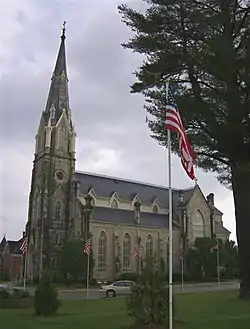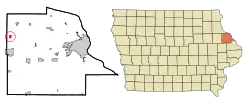New Vienna, Iowa
New Vienna is a city in Dubuque County, Iowa, United States. It is part of the Dubuque, Iowa Metropolitan Statistical Area. The population was 407 at the 2010 census, up from 400 in 2000. New Vienna is home to the Saint Boniface Catholic Church. The city promotes itself with the slogan The eNVy of Iowa.[4]
New Vienna, Iowa | |
|---|---|
 St. Boniface | |
 Location of New Vienna, Iowa | |
| Coordinates: 42°32′54″N 91°6′49″W | |
| Country | |
| State | |
| County | Dubuque |
| Area | |
| • Total | 0.47 sq mi (1.21 km2) |
| • Land | 0.47 sq mi (1.21 km2) |
| • Water | 0.00 sq mi (0.00 km2) |
| Elevation | 1,001 ft (305 m) |
| Population | |
| • Total | 407 |
| • Estimate (2019)[3] | 411 |
| • Density | 881.97/sq mi (340.48/km2) |
| Time zone | UTC-6 (Central (CST)) |
| • Summer (DST) | UTC-5 (CDT) |
| ZIP code | 52065 |
| Area code(s) | 563 |
| FIPS code | 19-56550 |
| GNIS feature ID | 0459494 |
Geography
New Vienna is located at 42°32′54″N 91°06′49″W (42.548404, -91.113568).[5]
According to the United States Census Bureau, the city has a total area of 0.44 square miles (1.14 km2), all land.[6]
History
New Vienna was initially settled by a group of German immigrant families who were living in Ohio. These families had come to the area in search of farmland.
One such family was that of William Steffen Sr. and his wife Mary. William and Mary were originally from Recklinghausen, in what was then the Province of Westphalia and today is Germany. They came to the United States and settled in Ohio. William and Mary and their children joined the other German immigrant families who came to New Vienna in the 1840s. The descendants of William and Mary number in the thousands today, and some of their descendants still live in New Vienna and surrounding areas.
St. Boniface Catholic Church was established for the local families that established New Vienna. This church is notable for its late 19th century William Schuelke pipe organ. This organ is one of the few original remaining Schuelke Organs - except for an electric blower it has been basically unaltered since installation.
Demographics
| Year | Pop. | ±% |
|---|---|---|
| 1900 | 245 | — |
| 1910 | 188 | −23.3% |
| 1920 | 241 | +28.2% |
| 1930 | 229 | −5.0% |
| 1940 | 229 | +0.0% |
| 1950 | 204 | −10.9% |
| 1960 | 265 | +29.9% |
| 1970 | 392 | +47.9% |
| 1980 | 430 | +9.7% |
| 1990 | 376 | −12.6% |
| 2000 | 400 | +6.4% |
| 2010 | 407 | +1.8% |
| 2019 | 411 | +1.0% |
| Source:"U.S. Census website". United States Census Bureau. Retrieved 2020-03-29. and Iowa Data Center Source: | ||
2010 census
As of the census[2] of 2010, there were 407 people, 173 households, and 118 families residing in the city. The population density was 925 inhabitants per square mile (357.1/km2). There were 180 housing units at an average density of 409.1 per square mile (158.0/km2). The racial makeup of the city was 98.8% White, 0.2% African American, 0.7% Asian, and 0.2% from two or more races. Hispanic or Latino of any race were 0.2% of the population.
There were 173 households, of which 29.5% had children under the age of 18 living with them, 59.5% were married couples living together, 6.4% had a female householder with no husband present, 2.3% had a male householder with no wife present, and 31.8% were non-families. 30.1% of all households were made up of individuals, and 16.1% had someone living alone who was 65 years of age or older. The average household size was 2.35 and the average family size was 2.93.
The median age in the city was 41.8 years. 23.8% of residents were under the age of 18; 5.4% were between the ages of 18 and 24; 25.8% were from 25 to 44; 25.5% were from 45 to 64; and 19.4% were 65 years of age or older. The gender makeup of the city was 50.4% male and 49.6% female.
2000 census
As of the census[8] of 2000, there were 400 people, 167 households, and 122 families residing in the city. The population density was 889.1 people per square mile (343.2/km2). There were 176 housing units at an average density of 391.2 per square mile (151.0/km2). The racial makeup of the city was 100.00% White. Hispanic or Latino of any race were 0.25% of the population.
There were 167 households, out of which 27.5% had children under the age of 18 living with them, 60.5% were married couples living together, 7.8% had a female householder with no husband present, and 26.9% were non-families. 25.7% of all households were made up of individuals, and 15.6% had someone living alone who was 65 years of age or older. The average household size was 2.40 and the average family size was 2.88.
21.8% are under the age of 18, 8.3% from 18 to 24, 25.3% from 25 to 44, 21.5% from 45 to 64, and 23.3% who were 65 years of age or older. The median age was 40 years. For every 100 females, there were 99.0 males. For every 100 females age 18 and over, there were 98.1 males.
The median income for a household in the city was $36,500, and the median income for a family was $46,875. Males had a median income of $31,375 versus $23,125 for females. The per capita income for the city was $25,285. About 7.0% of families and 6.8% of the population were below the poverty line, including 9.5% of those under age 18 and 7.8% of those age 65 or over.
Education
Residents are within the Western Dubuque Community School District.[9] Zoned schools include Drexler Elementary School in Farley,[10] Drexler Middle School in Farley, and Western Dubuque High School in Epworth.[11]
The remaining Catholic grade school in the "Spires of Faith" Catholic church network, which operates Catholic churches in the area, is St. Francis Xavier Catholic School in Dyersville, and the secondary school is Beckman Catholic High School.[12]
The private Catholic primary school Archbishop Hennessy Catholic School previously had a location in New Vienna. The Hennessy School had been formed by the 1987 consolidation of the St. Boniface School in New Vienna and the SS. Peter & Paul School in Petersburg. In 2013 it consolidated into the Petersburg location,[13] and Archbishop Hennessy closed entirely in 2018.[14]
See also
References
- "2019 U.S. Gazetteer Files". United States Census Bureau. Retrieved July 17, 2020.
- "U.S. Census website". United States Census Bureau. Retrieved 2012-05-11.
- "Population and Housing Unit Estimates". United States Census Bureau. May 24, 2020. Retrieved May 27, 2020.
- "New Vienna, Iowa". The Dyersville Area Chamber of Commerce. Archived from the original on January 7, 2010. Retrieved October 5, 2009.
- "US Gazetteer files: 2010, 2000, and 1990". United States Census Bureau. 2011-02-12. Retrieved 2011-04-23.
- "US Gazetteer files 2010". United States Census Bureau. Archived from the original on 2012-01-25. Retrieved 2012-05-11.
- "Census of Population and Housing". Census.gov. Retrieved June 4, 2015.
- "U.S. Census website". United States Census Bureau. Retrieved 2008-01-31.
- "Western Dubuque." Iowa Department of Education. Retrieved on July 24, 2018.
- "2017 Elementary Boundaries." Western Dubuque Community School District. Retrieved on July 24, 2018. Detail on Luxemburg and New Vienna
- "WDHS Boundary map." Western Dubuque Community School District. Retrieved on July 24, 2018.
- "Home". St. Francis Xavier Catholic School. Retrieved 2020-04-18. - linked from the Spires of Faith homepage (as of 2020/04/18)--> As per this site Hennessy School had a relationship with Beckman Catholic "School". Hennessy Catholic School. 2001-06-06. Archived from the original on 2001-06-06. Retrieved 2020-04-18.
- Muilenburg, Matt (27 February 2013). "Hennessy School consolidation underway". Dyersville Commercial. Retrieved 27 February 2013.
- Wong, Allison (2017-09-21). "Hennessy Catholic School to close at the end of the school year". KCRG-TV. Retrieved 2020-04-07.